ngrok
Express Server, Socket.io
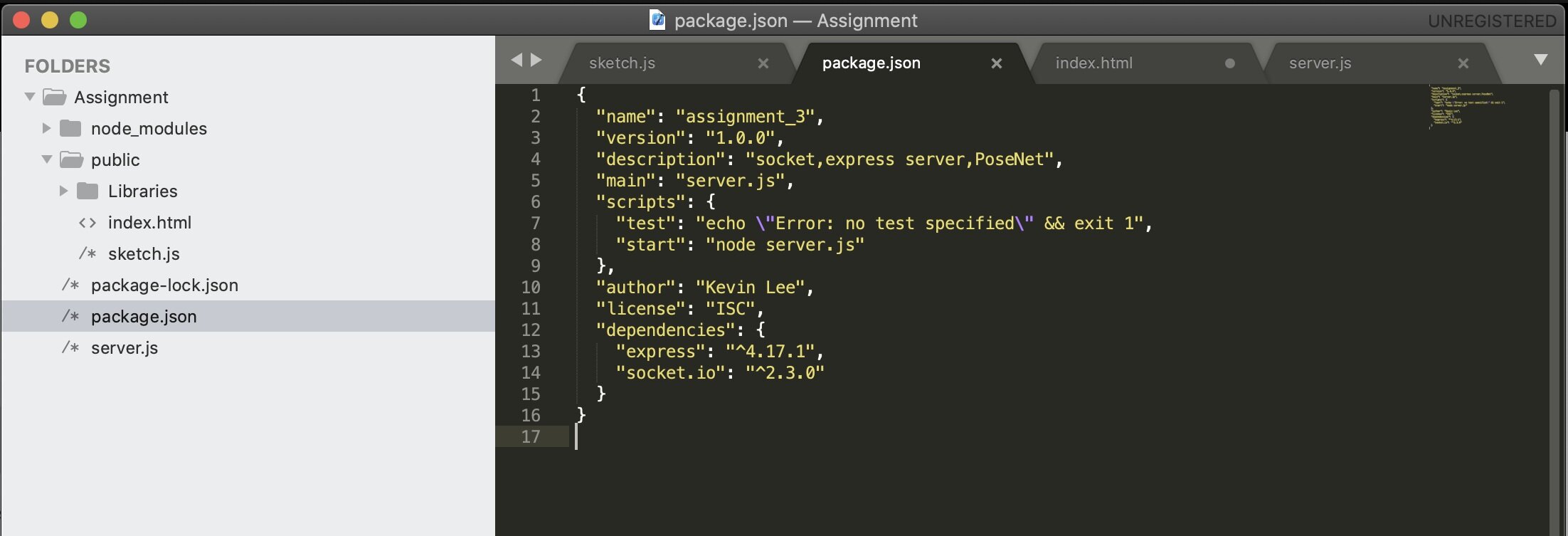
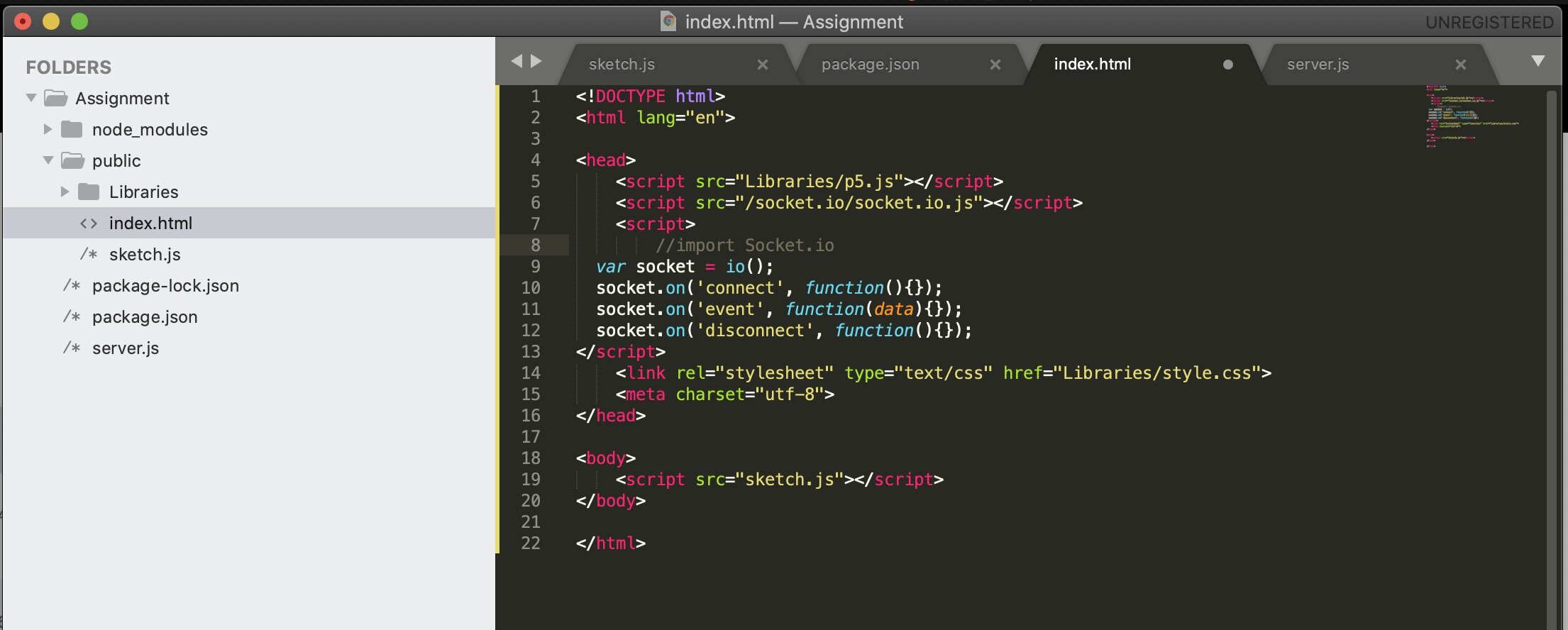
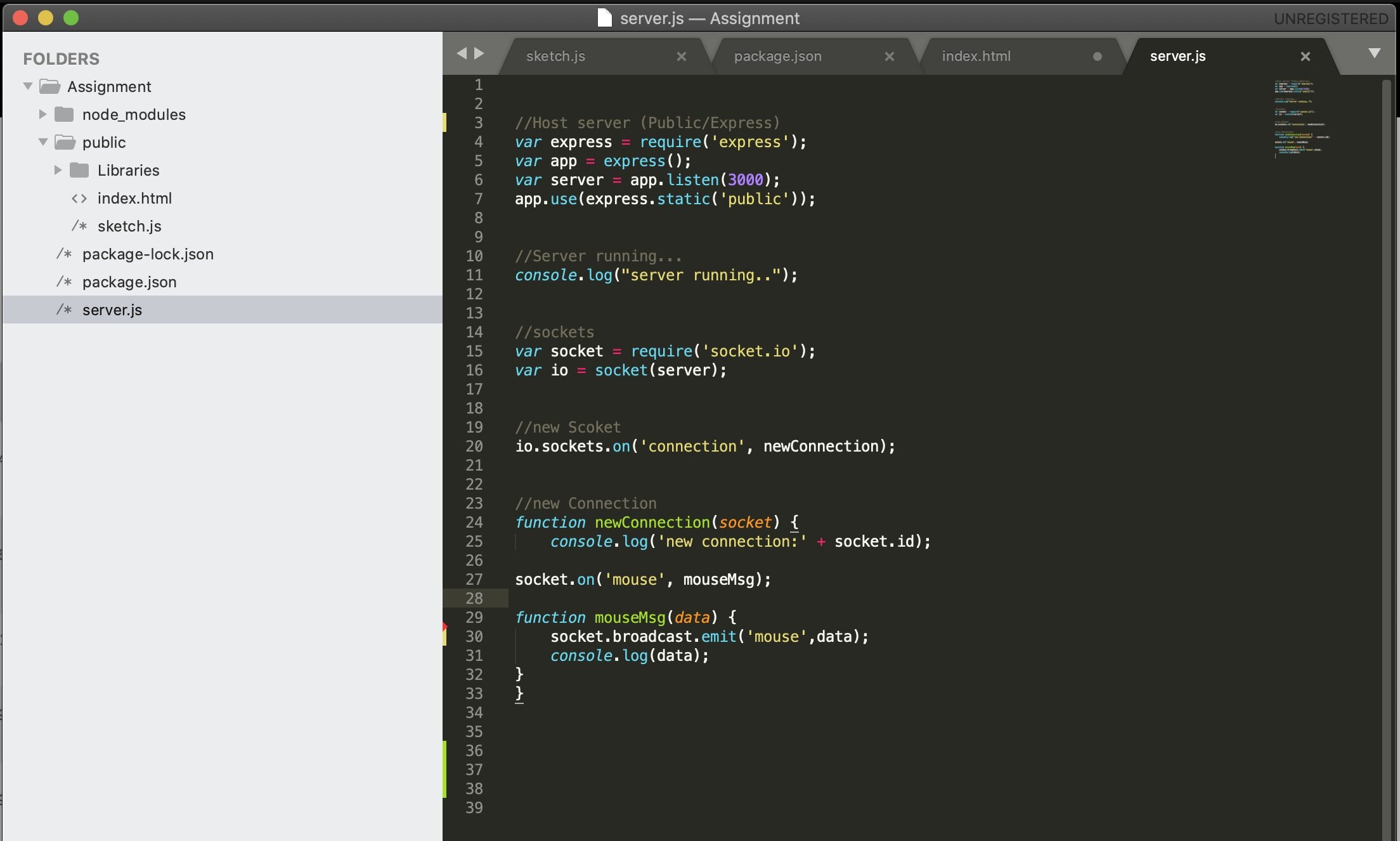
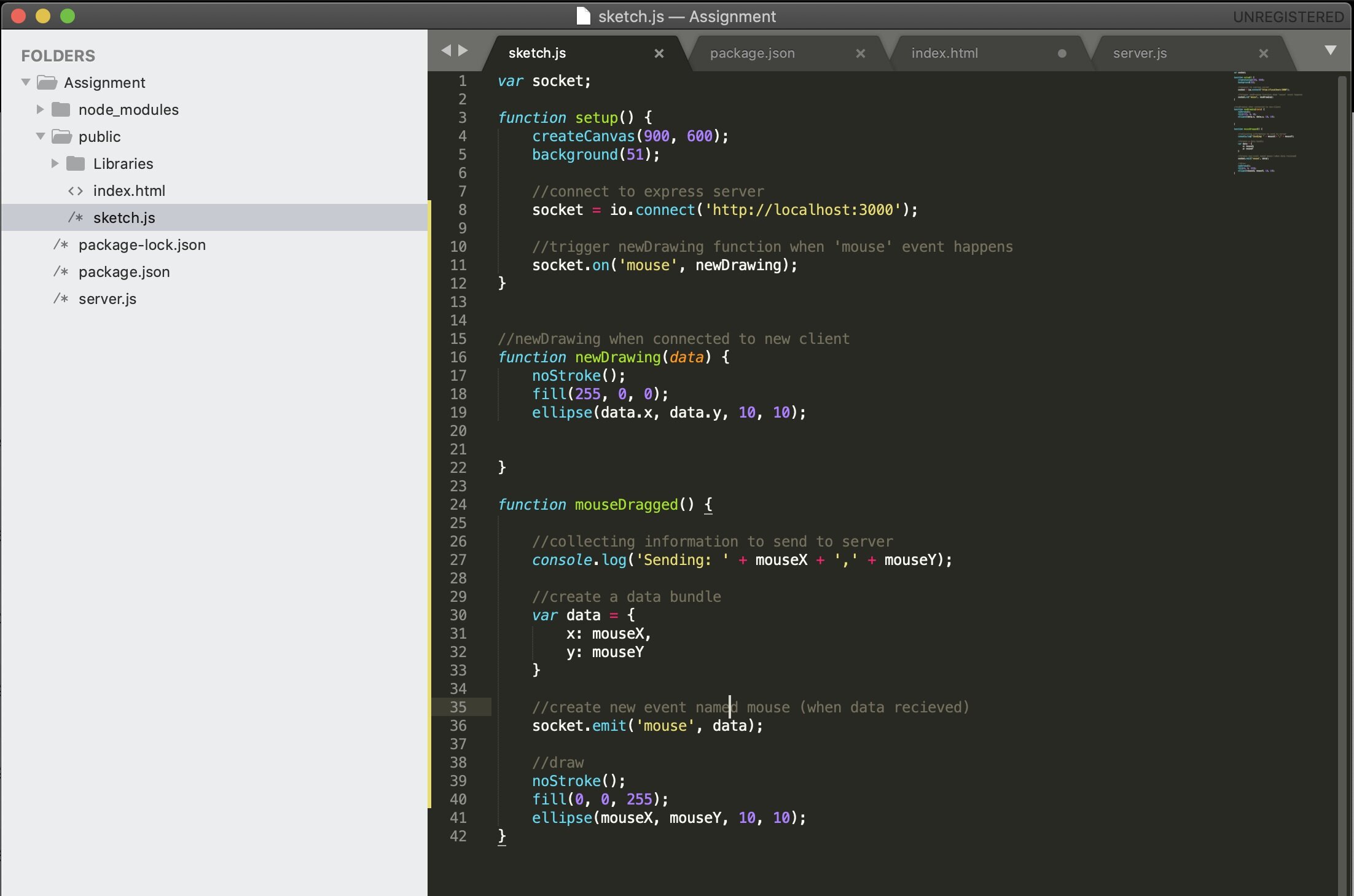
Study Notes
Reference & Tutorials
Class Note


This code might not work on this website because you need a webcam permission.
You can try on P5 editor. (There is a link to p5 editor on the right)
let myVideo; let pastPixels = []; let threshSlider function setup() { createCanvas(640, 480); myVideo = createCapture(VIDEO); myVideo.size(width, height); myVideo.hide(); threshSlider = createSlider(0, 255, 40); } function draw() { myVideo.loadPixels(); const currentPixels = myVideo.pixels; let threshValue = threshSlider.value(); for (let y = 0; y < height; y++) { for (let x = 0; x < width; x++) { const i = (y * width + x) * 4 const rDiff = abs(currentPixels[i + 0] - pastPixels[i + 0]); const gDiff = abs(currentPixels[i + 1] - pastPixels[i + 1]); const bDiff = abs(currentPixels[i + 2] - pastPixels[i + 2]); // set past pixels to current pixels pastPixels[i + 0] = currentPixels[i + 0]; pastPixels[i + 1] = currentPixels[i + 1]; pastPixels[i + 2] = currentPixels[i + 2]; pastPixels[i + 3] = currentPixels[i + 3]; avgDiff = (rDiff + gDiff + bDiff) / 3; if (avgDiff < threshValue) { currentPixels[i + 0] = random(255); currentPixels[i + 1] = random(255); currentPixels[i + 2] = random(255); currentPixels[i + 3] = 30; } else { currentPixels[i + 0] = 0 currentPixels[i + 1] = 0 currentPixels[i + 2] = 0 currentPixels[i + 3] = 255; } } } myVideo.updatePixels(); image(myVideo, 0, 0, width, height); }
How do single cell organisms coordinate sophisticated behaviors?
Plan
p5 - Nutrient
//user can use mouse-click to place blue dots. //yellow dot will build the optimized network connecting all blue dots //define Slime array & network array var nutrients = []; function setup() { createCanvas(800, 800); } //place Nutrient when user press mouse function mousePressed() { var n = new Nutrient(mouseX,mouseY,5); nutrients.push(n); } function draw() { background(220); // nutrients for (i=0; i<nutrients.length; i++) { nutrients[i].display(); } } //Nutrient function Nutrient (x,y,m) { //pos,vel,acc,mass (Just in case for later use) this.pos = createVector(x,y); this.vel = createVector(0,0); this.acc = createVector(0,0); this.mass = m; // color,shape of Nutrient this.display = function() { fill(0,0,255); ellipse(this.pos.x,this.pos.y,this.mass,this.mass); } }
p5 - Mold (Random Walker)
//create Array of slimes var slimes = [] function setup() { createCanvas(800, 800); background(220); for (let i = 0; i < 36; i++) { slimes[i] = new Slime(width / 2, height / 2, 0.5); } //make slimes to leave the trail for (let i = 0; i < 36; i++) { slimes[i].display(); } } function draw() { for (let i = 0; i < 36; i++) { slimes[i].display(); slimes[i].update(); } } function Slime(x, y, m) { //set up pos,vel,acc,mass this.pos = createVector(x, y); this.vel = createVector(0, 0); this.acc = createVector(0, 0); this.mass = m; //display (color, ellipse) this.display = function() { noStroke(); fill(0); ellipse(this.pos.x, this.pos.y, this.mass); } this.update = function() { this.vel.add(this.acc); this.pos.add(this.vel); this.acc.set(0, 0); //Movement of Slimes var movement = p5.Vector.random2D(); movement.mult(1.2); this.pos.add(movement); } }

The Starry Night

Painting by Vincent van Gogh

To begin with, I searched about Aerodynamic Force and Fluid Dynamics. But there were too many equations and laws involved.
Instead of using equations and laws of physics that I never knew and don’t understand to express nature ,
I decided to experiment and simulate it with my knowledge first.

By Thierry Dugnolle - Own work, CC0, Link
Idea sketch

Simulation Room
In order to simulate aerodynamics, I designed this room.

WIND
Trying to draw out wind Vector
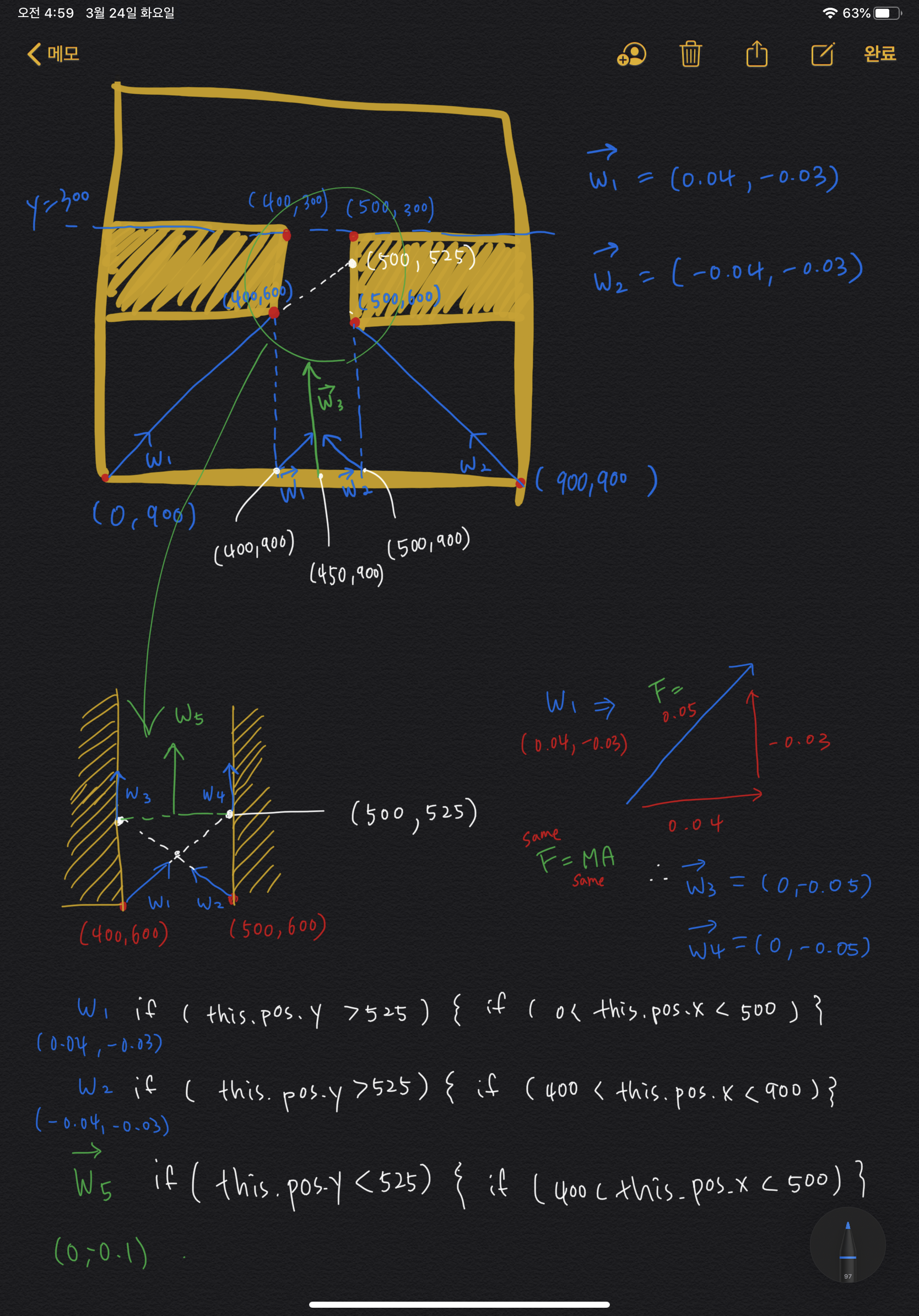
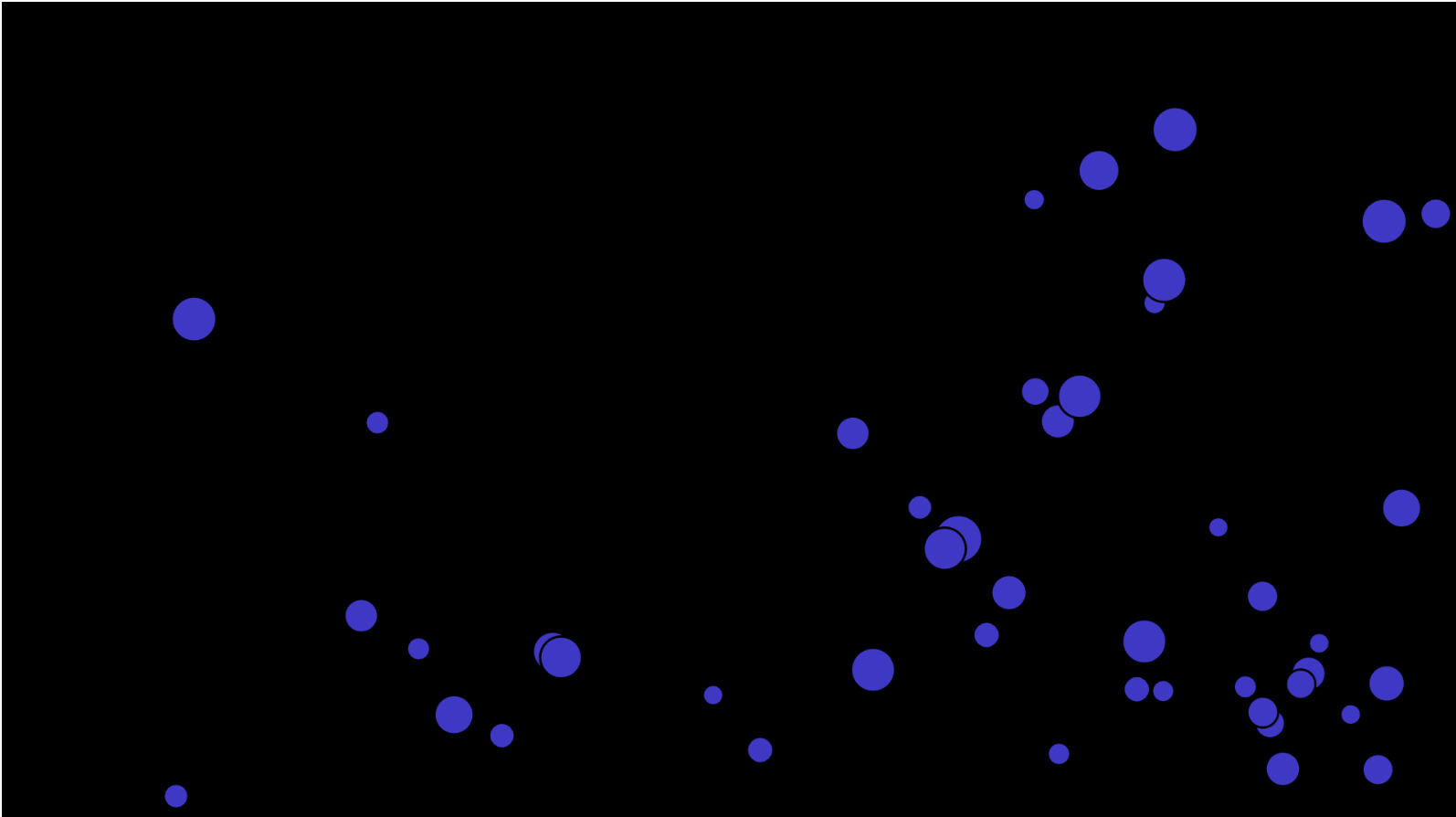
// var attractors var particles = [] let value = 0 var r var g var b function setup() { createCanvas(640, 360); } function mousePressed() { var p = new Particle(mouseX, mouseY, random(3, 7)) particles.push(p); r = random(255); g = random(255); b = random(255); } //draw particles function draw() { background(0); for (i = 0; i < particles.length; i++) { var gravity = createVector(0, 0.1 * particles[i].mass); var wind = createVector(0.05 * particles[i].mass,0); particles[i].applyForce(gravity); particles[i].applyForce(wind); particles[i].display(); particles[i].update(); particles[i].edges(); } } // create Walker class function Particle(x, y, m) { //set up pos,vel,acc,mass this.pos = createVector(x, y); this.vel = createVector(0, 0); this.acc = createVector(0, 0); this.mass = m //display this.display = function() { fill(r,g,b); ellipse(this.pos.x, this.pos.y, this.mass * 3, this.mass * 3); } //FORCE this.applyForce = function(force) { var f = force.copy(); f.div(this.mass) this.acc.add(f) } //physics engine this.update = function() { var mouse = createVector(mouseX, mouseY); this.vel.add(this.acc); this.pos.add(this.vel); this.acc.set(0, 0); } //create border this.edges = function() { if (this.pos.y > height - this.mass * 3 / 2) { this.vel.y *= -1 this.pos.y = height - this.mass * 3 / 2; } if (this.pos.x > width - this.mass * 3 / 2) { this.vel.x *= -1 this.pos.x = width - this.mass * 3 / 2; } if (this.pos.y - this.mass * 3 < 0) { this.vel.y *= -1 this.pos.y = this.mass * 3; } if (this.pos.x < this.mass * 3 / 2) { this.vel.x *= -1 this.pos.x = this.mass * 3 / 2; } } }
I spent this week to review Object oriented Programming, Vector, Vector Addition, and Vector Math
https://editor.p5js.org/kevinhb92/sketches/4PB50oBX : Mouse Vector - Position Vector
https://editor.p5js.org/kevinhb92/sketches/BlvIsb10 : Acceleration Vector
We learned about random walks for the first class of the Nature of Code. I wanted to create a 3D animatic nature scene using Random Walk. I wanted to depict the movement of the insects (ants, bees).
In order to do that, I created a 3D perspective scene using photoshop and PNG images. so that I can move insects into and out of the screen. However, I couldn’t find how to move my object in and out of the screen so I just focused on the 2D plane for today. Since I started programming with laying out images, movement and dynamics were not strong enough. I will limit my visual presentation next time and focus on movement and interesting shapes and patterns that movement makes.

Three.js, Local Server, Visual Studio Code



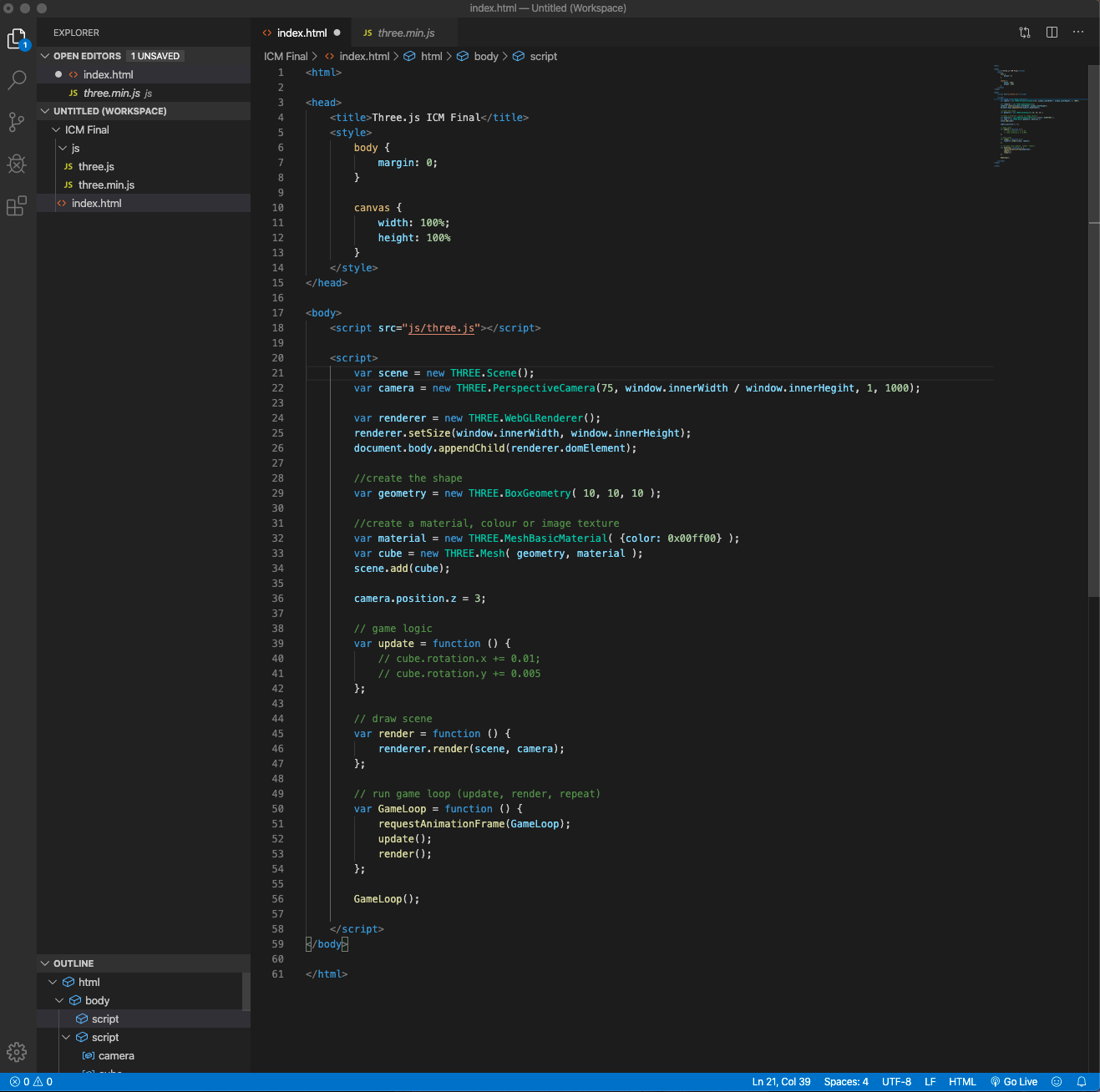
Project Idea: A.I. eyeball (VIDEO about eyeball)
Idea Sketch (Inspiration VIDEO)

Parts of the Eye
The human eye is like a camera:
Iris- like the diaphragm of a camera it controls the amount of light entering. It is the coloured part of the eye and opens and closes around a central hole to control the light entering the eye.
Pupil- this is the hole in the iris. It is like the aperture in a camera which is where the light enters.
Cornea and Lens- these cause light to converge creating a sharp image. The cornea is a transparent bulge on top of the pupil that focuses light. Light is refracted more through the cornea than the lens.
Light sensitive cells- these cells act like film in a camera, they “store” the image.
Retina- converts light signals into electrical signals that will travel to the brain.
Optic Nerve- used to transmit the signals from the retina to the brain.

I set out to create a practical and realistic musical launchpad that I could use effectively. My goal was to have a device that was not only functional but also labeled in a way that would make it easy to navigate and adjust the code and sound files as needed.
In order to demonstrate that the machine worked, I spent a considerable amount of time carefully selecting sounds that fit my personal style. I then played these sounds on a DJ mixer (XDJ-RX2) and adjusted the BPM to 125 before recording and exporting the final product. To create a seamless loop, I cut out two bars of music and used Javascript to loop the sound. For one-shot sounds like the Kick and Hi-hat, I manually adjusted the loop rate to match the BPM of the other sounds. Since each sound had a different length, I had to use my ears to make sure that everything matched up correctly.
I'm pleased with the final product and I hope you enjoy it as much as I do!
Load Sound
Buttons A1 - F6 (1~36)
Kick & Hi-Hat (Hand tuned and adjusted rate to match bpm)
Music

Sample Video
p5 editor: Interactive Visualizer
Recently, I became interested in exploring the capabilities of 'TouchDesigner'. I wanted to create a visualizer that featured geometric shapes and lines, and as I delved deeper into the software's capabilities, I became fascinated with the beauty of repetitive and reflected visuals. While playing around with the camera and pixel, I realized that the shape of the hand could evoke unique emotions. Conductors of symphony orchestras deliver their very detailed interpretation with their hand gestures, and this inspired me to create a visualizer that users can control with their hands.
HOW TO USE
Now, I invite you to become the conductor of my visualizer!
Adjust the brightness of the visualizer to your liking using the slider on the bottom.
Use your left hand to guide the visualizer according to the music. (Right-handed users can use the mouse to interact with the visualizer)
Click the mouse (left-click) in time with the beat of the music.
Try experimenting with different hand gestures, including rock, scissors, and paper.
Bring your hand closer to the camera during climactic moments in the music.
I intentionally designed the visualizer to react to the left hand (left side of the camera) so that users can use the mouse with their right hand. This allows for a more immersive experience as users can engage with the visualizer using both hands.
Music can enhance the visualizer, while the experience you get from the visualizer can enhance your engagement with the music, including its interpretation, rhythm, and emotion.
I hope you enjoy using my visualizer!
p5 editor: Interactive Visualizer
Week 1:
As someone trained in both art/design and computational media, I've learned to see the world from both macro and micro perspectives. Art and design have taught me to observe and break down the world from a larger scale (100 to 1), while computational media has taught me to build and create from the smallest units (1 to 100). In today's world, the fields of engineering, arts, design, and technology are all interconnected, and I am proud to contribute to the diverse range of human development that arises from these interrelationships.
Week 7:
As I sat down to eat dinner one day, I began to reflect on the nature of everyday activities. Eating, for example, involves many different variables such as seeing, smelling, moving our arms, chewing, tasting, and digesting. We often overlook the complexity of these everyday actions and take them for granted, which can cause us to miss out on important aspects of our lives such as our individuality, sense, emotion, and ability to discern and remember.
It's important to remember that computation is also a human creation, and that computers reflect the opinions, culture, customs, and ideas of those who programmed them. As coding becomes more prevalent in our lives, it is crucial that we acknowledge and appreciate the important role that coders and programmers play in shaping our future world.
As an artist
I believe that knowing how to code allows me to not only see the world from a smaller unit perspective but also to change the world in a fundamental way. Art is an integral part of our daily lives, and I am constantly amazed by its ubiquitous presence in everything from street signs to the design of doorknobs. As a designer and artist, I want to inspire people to appreciate and love the world around them and to take the time to see the beauty in even the smallest details.
For me, computation is a powerful tool that allows me to bring my artistic visions to life and create a world that is accessible to everyone, not just programmers and coders. I believe that the world can be great, but it is up to us to create that greatness.
I got inspired by Fidget Spinning. I wanted to create complex composition using Array, Class, Functions that makes 3D Optical illusion effect.
To begin with, I designed Spinning fidget that interact with location of mouse X and mouse Y.
Speed and color of Spinning fidget changes respect to mouseX and mouseY.
I coded background in setup in purpose in order to make 3D optical illusion.


Then I wanted to make it more complex. I wanted to generate Arrays of circles whenever user press the mouse. I wanted to make circles that swirl, accelerate, and gets bigger as it goes towards outside of window.
so I set variables for x location, y location, radius, angle, distance, speed.
whenever user press the mouse, circle that swirl generates.
circle gets bigger as it goes towards outside of screen
speed changes respect to speed of fidget spinning (mouseX value)
Then I made it to submit values when user press the mouse into array so that it draws circle
over and over again whenever user press the mouse.